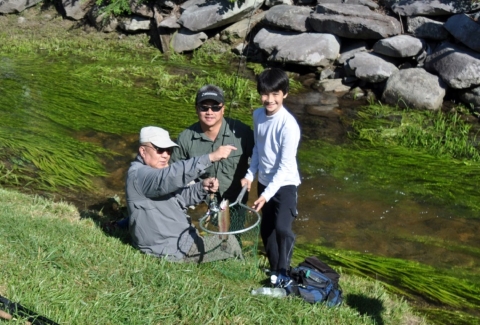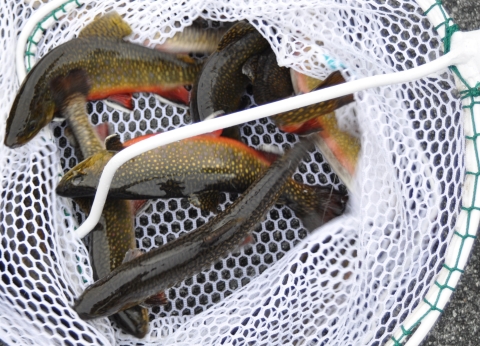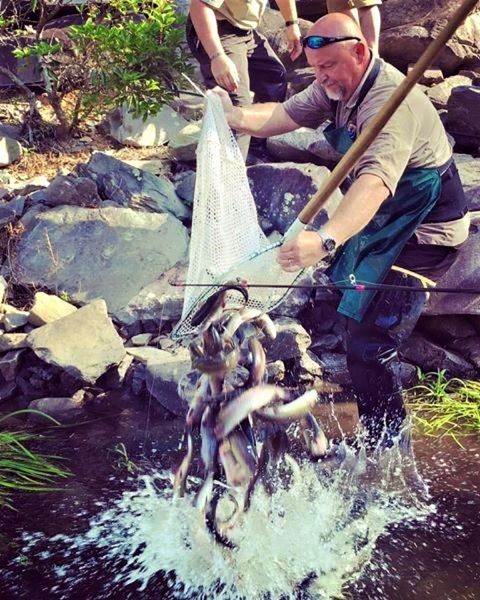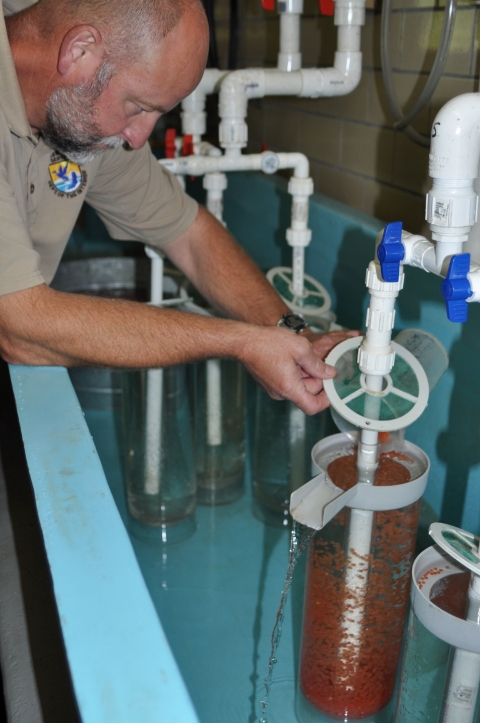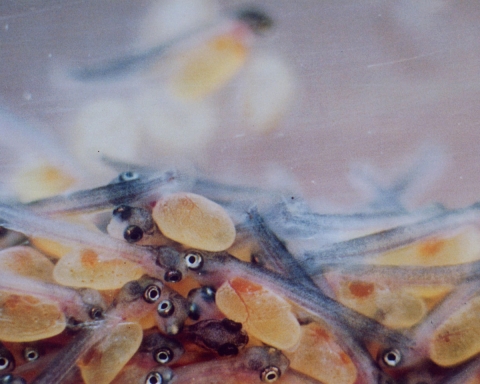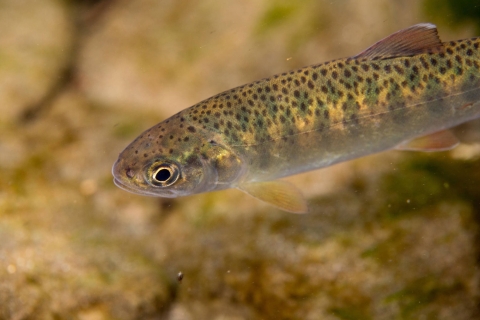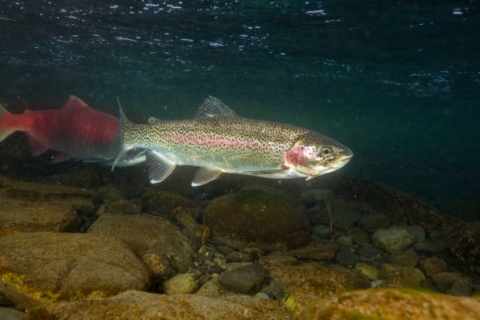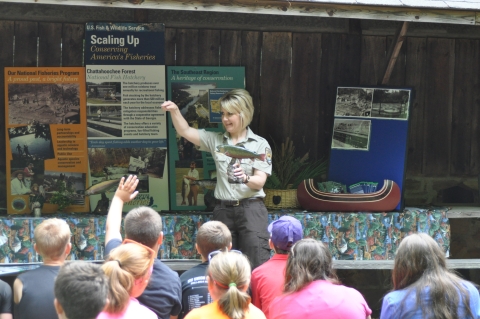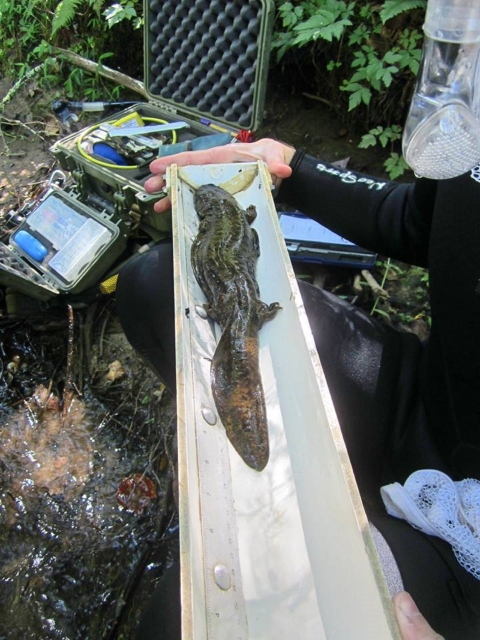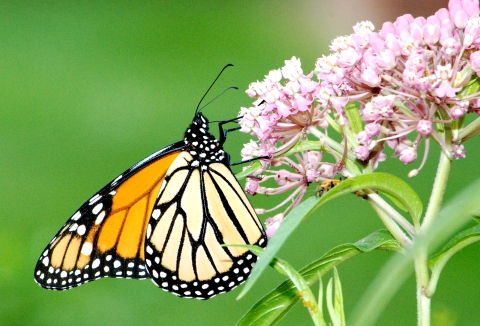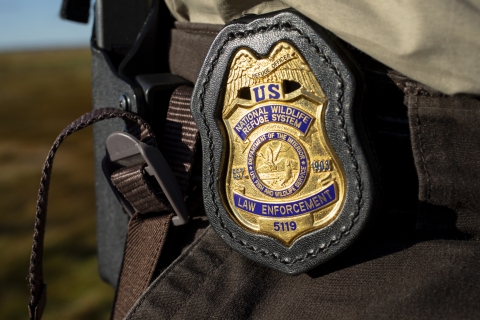What We Do
The next time you go fishing, you might just catch a fish that was raised at Chattahoochee Forest National Fish Hatchery. Since 1871, National Fish Hatcheries have been responding to conservation challenges affecting America’s fish and other aquatic species. Producing fish continues to be an irreplaceable tool in managing or restoring fisheries along with habitat conservation. In doing so, we help provide recreation opportunities to America’s 34 million anglers who spend $36 billion annually in pursuit of their favored pastime.
Management and Conservation
Chattahoochee Forest National Fish Hatchery is a cold water production facility that raises trout year round. Species currently produced here include rainbow, brook and brown trout. In cooperation with the Georgia Department of Natural Resources, U.S. Forest Service, U.S. Army Corps of Engineers and Tennessee Valley Authority, the fish are stocked in public waters throughout northern Georgia for recreational and mitigation purposes. In addition to fish aquatics, the hatchery is involved with conservation of the swamp pink plant, purple pitcher plant, monarch butterfly and eastern hellbender and efforts to conserve the bog turtle in partnership with the Georgia Department of Natural Resources.
Our Services
Trout Production and Stocking
Changes in water temperature and natural flow due to the environment, dams and reservoirs subsequently affect fish and aquatic resources. Fish are stocked in waters to serve important roles in the ecosystems and supplement fisheries.
Chattahoochee Forest National Fish Hatchery produces approximately one million trout per year that are stocked into public tailwaters, streams and lakes of northern Georgia in cooperation with the Georgia Department of Natural Resources, U.S. Forest Service, U.S. Army Corps of Engineers and Tennessee Valley Authority. Approximately 9 out of 10 trout caught in the state of Georgia come from the National Fish Hatchery system either as an egg, fingerling or stockable size trout.
The hatchery trout life cycle begins with fertilized eggs received from a broodstock broodstock
The reproductively mature adults in a population that breed (or spawn) and produce more individuals (offspring or progeny).
Learn more about broodstock hatchery. Eyed eggs, termed for the visibly developed eyes of the trout, come from either a federal broodstock hatchery or a state trout hatchery within the United States. Chattahoochee Forest National Fish Hatchery typically receives eggs from Erwin National Fish Hatchery in Tennessee and Ennis National Fish Hatchery in Montana.
The youth stages of trout are housed inside the hatchery building, which contains 23 troughs used for fish rearing. In this building, it is common to see various stages of trout life such as eggs, sac fry, and juvenile trout.
Eggs are placed in hatching jars. Water flows through these jars continuously, to mimic natural spawning habitat, to ensure proper oxygenation, and to deter fungal growth.
Water is gravity fed to the hatchery building by Mill Creek and Rock Creek. Water temperatures dip as low as the 30’s Fahrenheit in winter and can reach near 70° F in the extreme hottest part of the summer. Weather conditions, rainfall and drought have an affect on water level and temperatures.
From the time the eggs arrive, it takes approximately two weeks for hatching to occur. Once the eggs have hatched, the small fish are called alevin or sac fry, termed for the retained yolk sac on the underside of the fish. From the hatching jar to their own trough, the sac fry lie on the bottom, absorbing nutrients from their yolk sacs for approximately 2-3 weeks before beginning on feed.
Once the yolk sacs are absorbed, the young trout, known as fry, swim up from the bottom of the troughs and are fed commercial fish food 5-6 times per day. When they reach a size of approximately 3 inches (4-5 months old), the fingerling trout are transferred to outdoor fish rearing raceways.
The hatchery maintains 46 outdoor raceways for fish rearing. Fish within the raceways may be 3 inches up to 10-12 inches in length. Each raceway may contain anywhere from 8,000 to 100,000 fish, depending on size.
Once outside, the fish are fed and cared for until they reach stockable size. Most fish are stocked by the time they reach 9 inches long, which takes approximately 12-14 months to achieve, from egg to stockable size. Each raceway of fish may be fed from one to three times a day depending on the size of the fish.
Throughout the year, staff harvest trout from the raceways, distribute by truck, and stock in designated waters. Trout produced at the hatchery enhance and increase recreational fishing opportunities in the public waters of Georgia. The contributions of this hatchery have provided a profound economic boost to not only local communities, but to citizens of the state of Georgia and to Americans nationwide.
Economic Impact
The high quality and efficient trout production at Chattahoochee Forest National Fish Hatchery is just one aspect of its fish production that creates a positive ripple effect for all Americans. Recreational angling for fish produced by the hatchery results in considerable expenditures of recreation-related goods and services such as lodging, transportation, boats, fishing equipment, and other gear used by the fishing public. According to studies, the total economic output for trout production at Chattahoochee Forest National Fish Hatchery amounts to $30.3 million dollars each year. That means for every tax dollar spent to operate the hatchery more than $40 are generated and contributed back to the economy.
Public Use Opportunities
The hatchery operates and maintains an outdoor visitor kiosk, environmental education center and pavilion that accommodates thousands of visitors annually from all over Georgia, across the United States and other countries. Annual fishing events for youth, senior citizens and veterans as well as education and outreach events for the public are offered throughout the year. A diverse array of public use opportunities are available at the hatchery and in the surrounding Chattahoochee National Forest and Blue Ridge Wildlife Management Area. Check out the Visit Us page for more information.
Environmental Education and Connecting People with Nature
Chattahoochee Forest National Fish Hatchery is just one of the many field stations of the U.S. Fish and Wildlife Service whose mission is working with others to conserve, protect, and enhance fish, wildlife, and plants and their habitats for the continuing benefit of the American people. In addition to onsite tours and presentations geared to educating and connecting people with nature, the hatchery also participates in offsite activities and events in partnership with other groups and agencies such as the University of Georgia, Trout Unlimited and local school systems. Please contact Project Leader Kelly Taylor for more information.
Our Projects and Research
Bog Turtle
The Chattahoochee Forest National Fish Hatchery has been partnering with Georgia Department of Natural Resources surveying bog turtles in the northern Georgia for the past several years. The Southern population of bog turtles is considered threatened by association.
“Bog turtlesare perhaps the rarest reptile in the United States . . . Southern Appalachian mountain bogs are one of the most critically endangered wetland ecosystems in the United States . . . As the north Georgia mountains became settled and developed, low-lying and relatively flat areas, including bogs, were targeted as ideal locations for towns, roads, reservoirs, and farms. One of the main threats to bogs now is the takeover by trees and shrubs (succession), which shade out rare bog plants and animals that need full sunlight to survive. The result is the decline and loss of plants and animals associated with this habitat including the bog turtle and swamp pink plant . . .”
- Georgia Department of Natural Resources Wildlife Division.
Swamp Pink Plant
"Swamp pink is only found in wetlands along streams and seepage areas in freshwater swamps. The major threat to the species is loss and degradation of its wetland habitat due to encroaching development, sedimentation, pollution, succession, and wetland drainage. Swamp pink has extremely low seedling establishment, which appears limit establishment of population at new sites. Other threats include plant collection and trampling.
In order to remove swamp pink from the endangered species list, biologists must stabilize the range-wide status of the species by:
- securing permanent land protection for a minimum of 80 sites;
- ensuring long-term regulatory protection of all extant populations and their habitat at the state and local levels; and
- if needed, maintaining representative genotypes in cultivation."
- U.S. Fish and Wildlife Service
Purple Pitcher Plant
"The Mountain purple pitcher plant is a perennial herb with leaves modified into inflated pitchers. Pitchers are 2 - 18 inches long, often resting on the ground, and green with purple veins. The pitcher is widest at its middle, with a wing on the upper side and an erect, wavy-edged hood. Threats to the plant include ecosystem-wide hydrology changes due to habitat conversion, habitat loss, and fire suppression. Use of herbicides in powerline rights-of-way may have impacts on certain populations. Pitcher plants are also threatened by collectors and off-road vehicle use in some areas. Digging and rooting by feral hogs is also a threat to the species. Rangewide, the plant is considered rare with only a few dozen populations in mountain and seepage bogs of the Blue Ridge Mountains and adjacent piedmont of southwestern North Carolina (south of Asheville County), northwestern South Carolina (Greenville County), and northeastern Georgia (Rabun County). "
- U.S. Fish and Wildlife Service
Eastern Hellbender
As early as 1957 researchers noted the hellbender’s range was rapidly shrinking as a result of modification of stream habitats. Among the threats to stream habitats are the accumulation of silt, agricultural and industrial pollution, warming waters, as well as the channelization and impoundment of streams and rivers.
Hellbenders breathe primarily through their skin and rely on cool, well-oxygenated, flowing water. The construction of dams stops swift water flow, resulting in warmer temperatures and lower oxygen levels.
Although it is illegal in many states to sell hellbenders, the illegal pet trade may be contributing to the species decline.
How you can help
- Educate the public on the important role these animals play as indicators of healthy streams.
- Dispel myth that eastern hellbenders are venomous, which can lead to anglers killing the species when caught on a line
- U.S. Fish and Wildlife Service
Monarch Butterfly
Chattahoochee Forest National Fish Hatchery also serves a vital role in helping save the monarch butterfly and has established and maintains a butterfly habitat on the hatchery grounds:
“The monarch butterfly is one of the most recognizable species in North America and it’s in trouble. Monarchs inspire people; and their habitat supports pheasant, quail, waterfowl and many other species. Their habitat also provides outdoor recreation opportunities, like hunting and wildlife observation. Habitat loss and fragmentation has occurred throughout the monarch’s range. Pesticide use can destroy the milkweed monarchs need to survive. A changing climate has intensified weather events which may impact monarch populations.”
- U.S. Fish and Wildlife Service.
Law Enforcement
For information about the U.S. Fish and Wildlife Service law enforcement programs across the United States, please visit the Office Law of Enforcement.
Laws and Regulations
| Image Details
For information about laws, regulations and licensing requirements for trout fishing in the state of Georgia, please visit the Georgia Department of Natural Resources.




